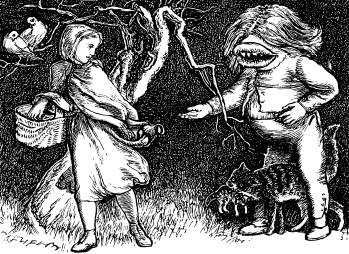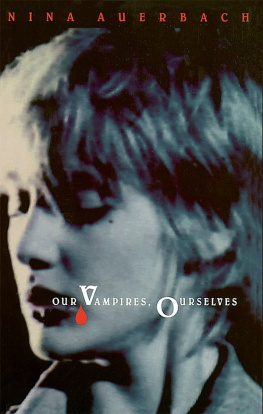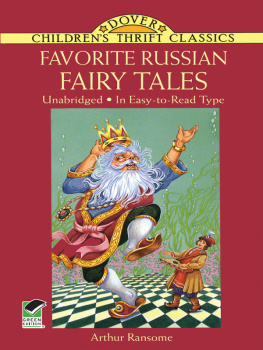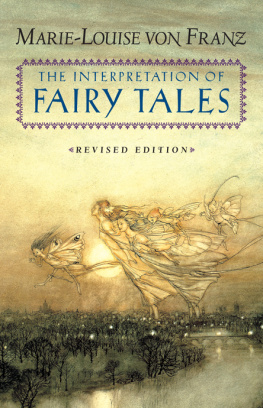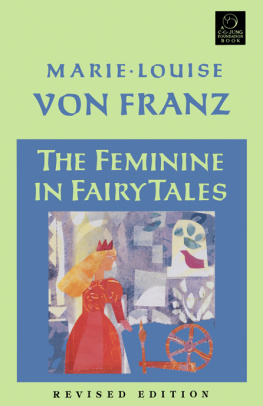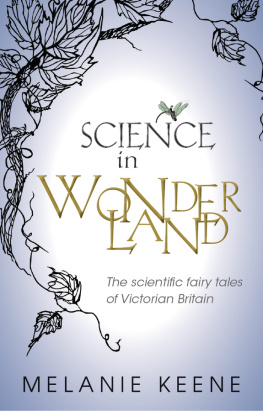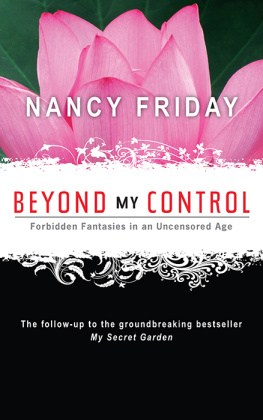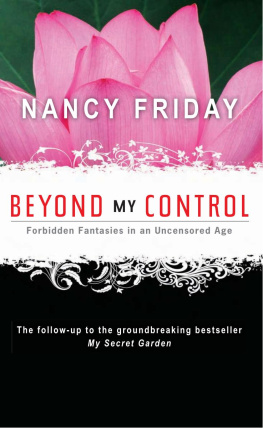NINA AUERBACH, professor of English at the University of Pennsylvania, is the author of Romantic Imprisonment and Private Theatricals .
U. C. KNOEPFLMACHER, professor of English at Princeton University, is the author of Laughter and Despair: George Eliots Early Novels and Bront: Wuthering Heights .
The University of Chicago Press, Chicago 60637
The University of Chicago Press, Ltd., London
1992 by the University of Chicago
All rights reserved. Published 1992
Printed in the United States of America
01 00 99 98 97 96 95 94 93 92 5 4 3 2 1
ISBN (cloth): 0-226-03203-5
ISBN 978-0-226-23052-8 (e-book)
Library of Congress Cataloging-in-Publication Data
Forbidden journeys : fairy tales and fantasies by Victorian women writers / edited by Nina Auerbach and U. C. Knoepflmacher.
p. cm.
Includes bibliographical references.
ISBN 0-226-03203-5 (cloth)
1. Fantastic fiction, English. 2. English fictionWomen authors. 3. English fiction19th century. 4. Childrens stories, English. 5. Fairy talesGreat Britain. I. Auerbach, Nina, 1943 . II. Knoepflmacher, U. C.
PR1309.F3F6 1992
823'.08766089287dc20
9131824
CIP

The paper used in this publication meets the minimum requirements of the American National Standard for Information SciencesPermanence of Paper for Printed Library Materials, ANSI Z39.48-1984.
ISBN 978-0-226-23052-8 (e-book)
FORBIDDEN JOURNEYS
Fairy Tales and Fantasies by Victorian Women Writers
Edited by Nina Auerbach and U. C. Knoepflmacher
The boy with the great mouth full of teeth grins at Maggie
The University of Chicago Press
Chicago and London
Contents
ANNE THACKERAY RITCHIE
ANNE THACKERAY RITCHIE
MARIA LOUISA MOLESWORTH
JULIANA HORATIA EWING
CHRISTINA ROSSETTI
JULIANA HORATIA EWING
FRANCES HODGSON BURNETT
E. NESBIT
E. NESBIT
.
JEAN INGELOW
CHRISTINA ROSSETTI
Introduction
Victorian readers found the association of women with childrens books natural, even inevitable, but it wasnt. Cultural and economic pressures made it more acceptable for women to write for children than for other adults, but the most acclaimed writers of Victorian childrens fantasies were three eccentric menLewis Carroll, George MacDonald, and James Barriewhose obsessive nostalgia for their own idealized childhoods inspired them to imagine dream countries in which no one had to grow up. The most moving Victorian childrens books are steeped in longing for unreachable lives. Carroll, MacDonald, and Barrie envied the children they could not be; out of this envious longing came their painful childrens classics.
Most Victorian women, including those whose stories we reprint here, envied adults rather than children. Whether they were wives and mothers or teachers and governesses, respectable womens lives had as their primary object child care. British law made the link between women and children indelible by denying women independent legal representation. As Frances Power Cobbe pointed out in a witty essay, Criminals, Idiots, Women, and Minors were identical in the eyes of the law. In theory, at any rate, women lived the condition Carroll, MacDonald, and Barrie longed for. If they were good, they never grew up.
Written under subtle cultural compulsion, the stories reprinted here are more abrasive than the better-known, more lovable childrens books by Victorian men; our authors often seem to chafe against childhood rather than to envy or idealize it. Yet constraint gives their stories a wonderful edge. Few readers will find them heartwarming; some, in fact, might be repelled or even shocked by their anger and violence. For though their choices were severely limited, women who wrote for children had surprising freedom of expression compared to writers of juvenile fiction today. The literary marketplace, like Victorian society in general, rewarded women for adhering to stereotyped roles. Once women conformed outwardly, an age still free of psychoanalytic suspicion exempted their emotions from close inspection.
In New Grub Street (1891), a grimly realistic novel about the pressures the literary marketplace imposed on late-Victorian authors, George Gissing portrays the ease with which an untalented woman carves out a career writing for children. All the authors in New Grub Street who have some authentic connection to literature starve, die, or fail humiliatingly, but Dora Milvain simply obeys her careerist brother and adapts her wares to the market he describes: But its obvious what an immense field there is for anyone who can just hit the taste of the new generation of Board school children. Mustnt be too goody-goody; that kind of thing is falling out of date. But youd have to cultivate a particular kind of vulgarity.
And Dora does. At the end, as literary lives fall into wreck around her, she is contentedly writing a very pretty tale which would probably appear in The English Girl . She marries Whelpdale, one of her successful brothers sycophants, who woos her in literary gush: You seem to me to have discovered a new genre ; such writing as this has surely never been offered to girls, and all the readers of [ The English Girl ] must be immensely grateful to you.
In Gissings context, Doras success as a childrens hack is bitterly ironic. We never learn what she writes, and the narrative implies that it doesnt matter; any formulaic hackwork will fill the pages of The English Girl , a magazine founded by a Mrs. Boston Wright, whose mixed background, respectable and yet also sufficiently unconventional, has apparently helped in setting the right tone. It is possible, though, that Whelpdale is right: for all we know Dora may have discovered a new genre. Juvenile literature was produced in such volume that it could flourish uncensored. Since Victorian children were perceived as secure in their innocence, there was no felt need to expurgate anger, subversion, or literary experimentation from their reading. Moreover, in the 1870s and 1880s, changes in the juvenile marketplace empowered some astonishingly bold and innovative writing by women.
In the 1840s and 50s, rigid didacticism had held childrens fiction in thrall. Had George Eliot, the three Bront sisters, or Elizabeth Gaskellall of whom turned to fiction writing in the late 1840s and 1850swanted to write for children, they would have had no choice but to join the ranks of female forbidders. In Charlotte Bronts angry account of a suppressed childhood, Jane Eyres passion for truth, her insistence on an exact tale, as well as her powerful romantic imagination, are exacerbated by her enforced reading, the drab book entitled the Childs Guide . Jane scornfully suggests to Mrs. Reed that she give this sententious narrative to your girl, Georgiana, for it is she who tells lies, and not I. To Jane Eyre, moralism is simply telling lies, but when the next generation of childrens literature expanded into wilder romance and fairy tale plots, even Jane Eyre would have been attracted to the forbidden emotional and psychic truths whose expression had now become possible.
Fairy tales and romances were grounded in an oral narrative tradition that may well have been initiated by women. The antiquity of fairy tales, their anonymous origins, had the feel (and perhaps the fact) of a lost, distinctively female tradition. Moreover, the wild magic of fairy tales, so guardedly approached even by the finest of the didacticists who dominated earlier juvenile literature, now seemed to license a new generation of writers as well as readers to be deviant, angry, even violent or satirical. For the most part, the trespassers in our anthology are untamed if not unpunished. Thus, while Gissings New Grub Street allows us to assume that Dora Milvain is a happy hack, her stories may replace the goody-goody with the startling subversion of the actual writers whose work this collection introduces: Jean Ingelow (18201897), Christina Rossetti (18301894), Anne Thackeray Ritchie (18371919), Maria Louisa Molesworth (18391921), Juliana Horatia Gatty Ewing (18411885), Frances Hodgson Burnett (18491924), and E. Nesbit (18581924).

 The paper used in this publication meets the minimum requirements of the American National Standard for Information SciencesPermanence of Paper for Printed Library Materials, ANSI Z39.48-1984.
The paper used in this publication meets the minimum requirements of the American National Standard for Information SciencesPermanence of Paper for Printed Library Materials, ANSI Z39.48-1984.